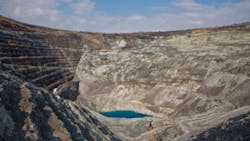A prospective primary magnesium producer will start construction of a pilot plant in southeastern Quebec, a step it said represents the first stage of a potential C$500-million development. Alliance Magnesium’s C$10-million pilot plant will demonstrate a patented electrolytic process powered by hydroelectricity to convert serpentine tailings from defunct mining operations in Asbestos, QC.
Alliance estimates the region has 800 million metric tons of serpentine tailings available as raw material.
Provincial officials in Quebec awarded an interest-free loan for $2.25 million for the pilot plant project.
The privately held company developed and patented the “electrolysis clean tech technology” to be demonstrated there. Reportedly, this demonstration will produce about 25 kg/day of magnesium metal. If it proves commercially viable, the company projects a 50,000-metric tons/year primary magnesium plant there.
"With a pilot factory, we will be testing a new clean process for producing the metal from tailings of serpentine rock from the Jeffrey mine,” stated Dr. Joël Fournier, president and CEO of Alliance Magnesium.
The site about 100 miles east of Montreal for many years was the location of chrysotile-asbestos mining operations, which resulted in very high volumes of serpentine rock tailings with 23.3% magnesium oxide content.
Electrolysis — the process of using direct electric current to create a chemical reaction in an ionic material in order to extract the metallic elements — has been used to produce primary magnesium for over 200 years. It’s the same concept used by primary aluminum producers to extract aluminum from refined bauxite ores.
Primary magnesium is much in demand as an alloying material for aircraft and automotive structures, though the cost of production and the environmental effects of magnesium smelting by standard processes have significantly diminished the number of suppliers.
Most industrial magnesium operations use electrolysis to extract magnesium from seawater or salt water. In the mid-1990s, Noranda proposed a primary magnesium project in the same region, to convert the serpentine tailings to primary magnesium. The Magnola project would have used leach tanks to concentrate the desired elements, followed by fluid-bed drying and a concentrator stage.
Specific details of the Alliance Magnesium technology have not been provided.
"Thanks to the use of the latest technologies, we have significantly improved the manufacturing process compared to our predecessors. Our process, in line with sustainable development, will allow us to substantially reduce the environmental footprint of the magnesium industry," Fournier stated.
"By working in partnership with the City of Asbestos and the other economic and social players in the region, we will produce an interesting alternative way of reducing greenhouse gases for the entire automobile and transportation industry. At the moment, the whole world is hungry for magnesium and we have to seize this opportunity," he added.
About the Author
Robert Brooks
Content Director
Robert Brooks has been a business-to-business reporter, writer, editor, and columnist for more than 20 years, specializing in the primary metal and basic manufacturing industries. His work has covered a wide range of topics, including process technology, resource development, material selection, product design, workforce development, and industrial market strategies, among others.
